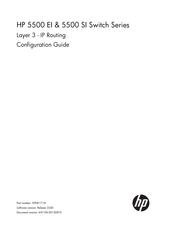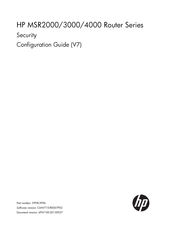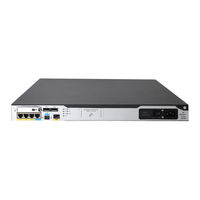HP MSR4000 Series Manuals
Manuals and User Guides for HP MSR4000 Series. We have 7 HP MSR4000 Series manuals available for free PDF download: Configuration Manual, High Availability Configuration Manual, Manual
HP MSR4000 Series Configuration Manual (453 pages)
Brand: HP
|
Category: Network Router
|
Size: 4.34 MB
Table of Contents
-
-
Introduction19
-
-
Overview33
-
-
-
-
Overview67
-
-
-
-
-
IS-IS Overview140
-
Basic Concepts140
-
IS-IS Area142
-
IS-IS PDU Format145
-
-
-
-
Advertisement
HP MSR4000 Series Configuration Manual (364 pages)
Brand: HP
|
Category: Network Router
|
Size: 3.41 MB
Table of Contents
-
-
Overview12
-
-
-
-
-
Overview80
-
-
-
Overview89
-
-
-
Overview100
-
FIPS Compliance100
-
-
Configuring PKI110
-
Overview110
-
PKI Terminology110
-
PKI Architecture111
-
PKI Operation112
-
PKI Applications112
-
-
FIPS Compliance113
-
HP MSR4000 Series Configuration Manual (455 pages)
MSR Series MPLS
Brand: HP
|
Category: Network Router
|
Size: 7.85 MB
Table of Contents
-
-
Overview10
-
-
-
Overview25
-
Terminology25
-
LDP Messages25
-
Ldp Gr29
-
Ldp Nsr30
-
Ldp Frr32
-
Protocols32
-
-
Enabling LDP33
-
-
-
Overview63
-
CRLSP Backup68
-
Frr68
-
-
-
-
Configuring RSVP152
-
Overview152
-
RSVP Messages152
-
Rsvp Gr154
-
-
Enabling RSVP155
-
Advertisement
HP MSR4000 Series Configuration Manual (350 pages)
HP MSR Router Series
Brand: HP
|
Category: Network Router
|
Size: 7.5 MB
Table of Contents
HP MSR4000 Series Configuration Manual (108 pages)
ACL and QoS
Brand: HP
|
Category: Network Router
|
Size: 1.34 MB
Table of Contents
-
-
Overview7
-
-
Qos Overview19
-
-
MQC Approach22
-
-
Overview30
-
HP MSR4000 Series High Availability Configuration Manual (91 pages)
Virtual Services Router
Brand: HP
|
Category: Network Router
|
Size: 0.91 MB
Table of Contents
-
-
Overview5
-
-
-
HP MSR4000 Series Manual (73 pages)
Brand: HP
|
Category: Network Router
|
Size: 7.12 MB
Table of Contents
Advertisement






